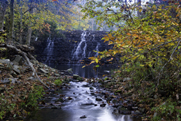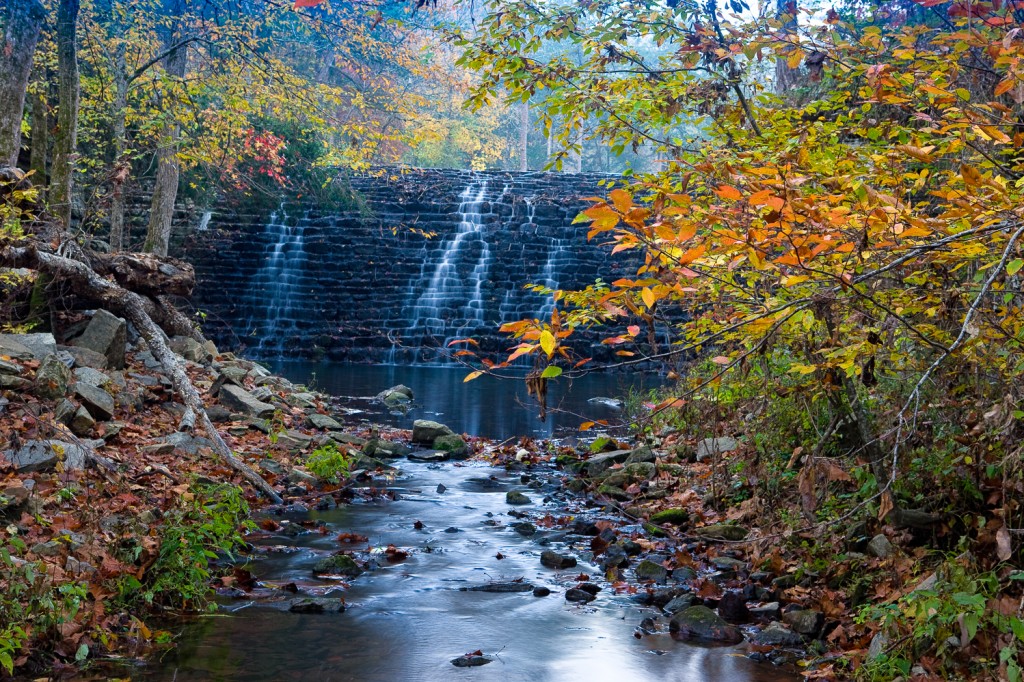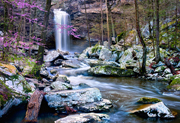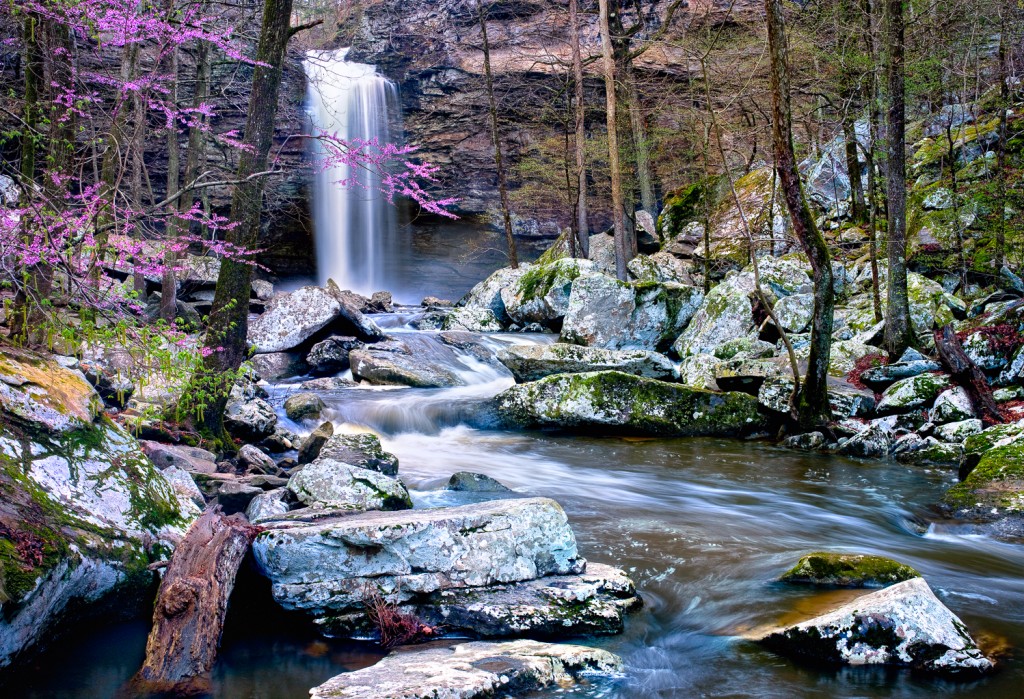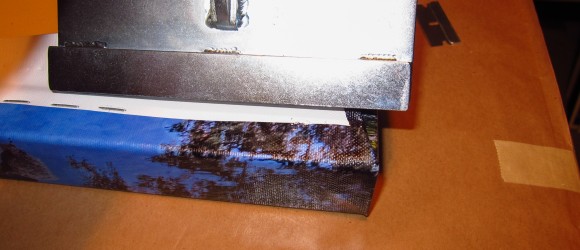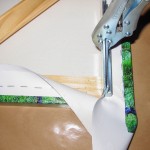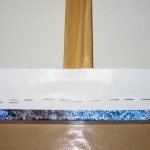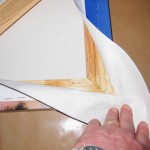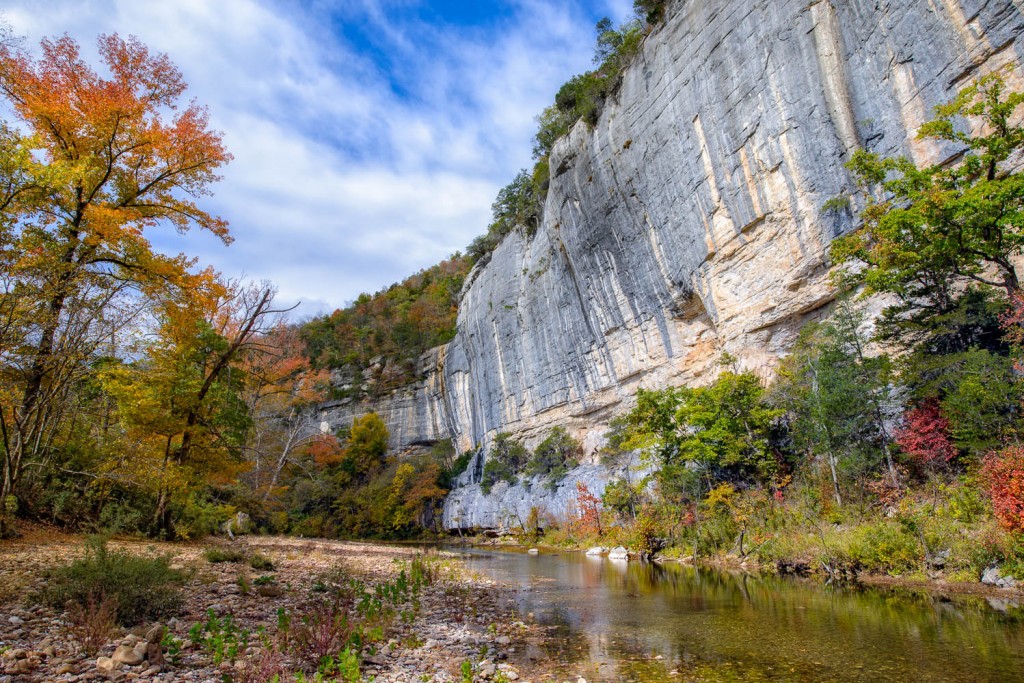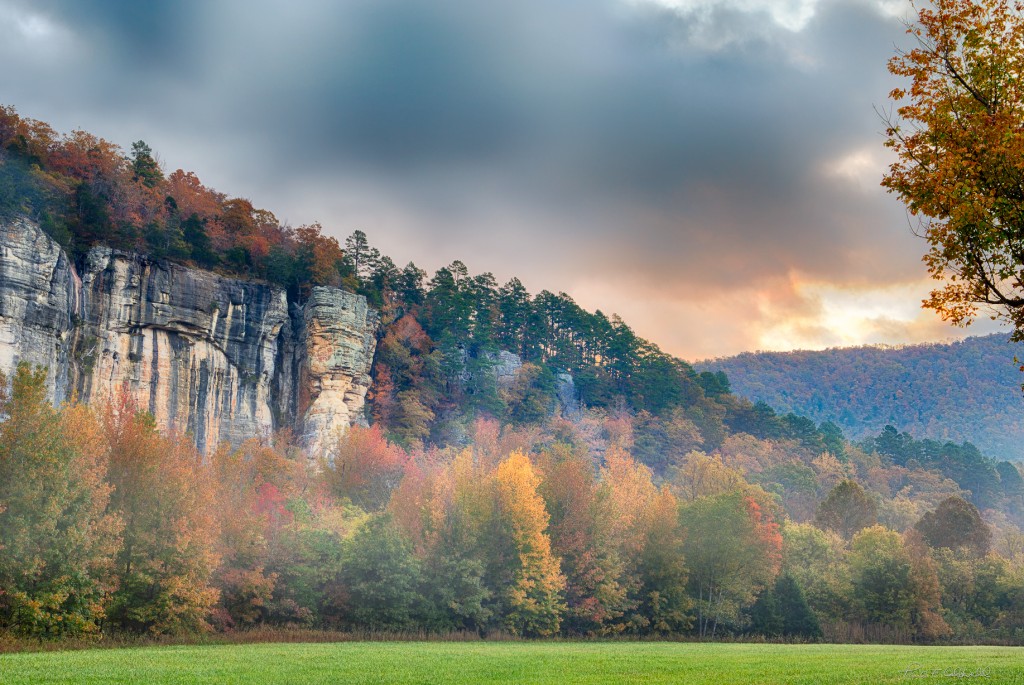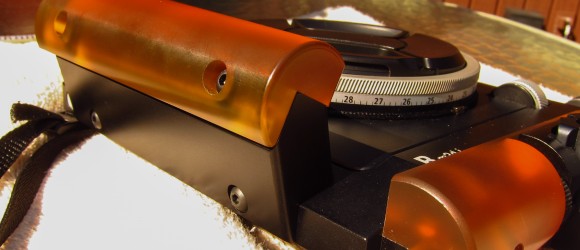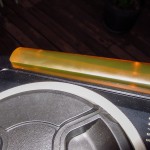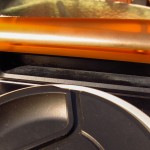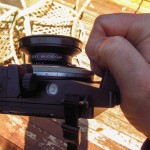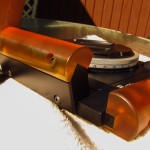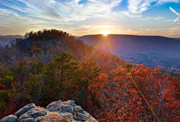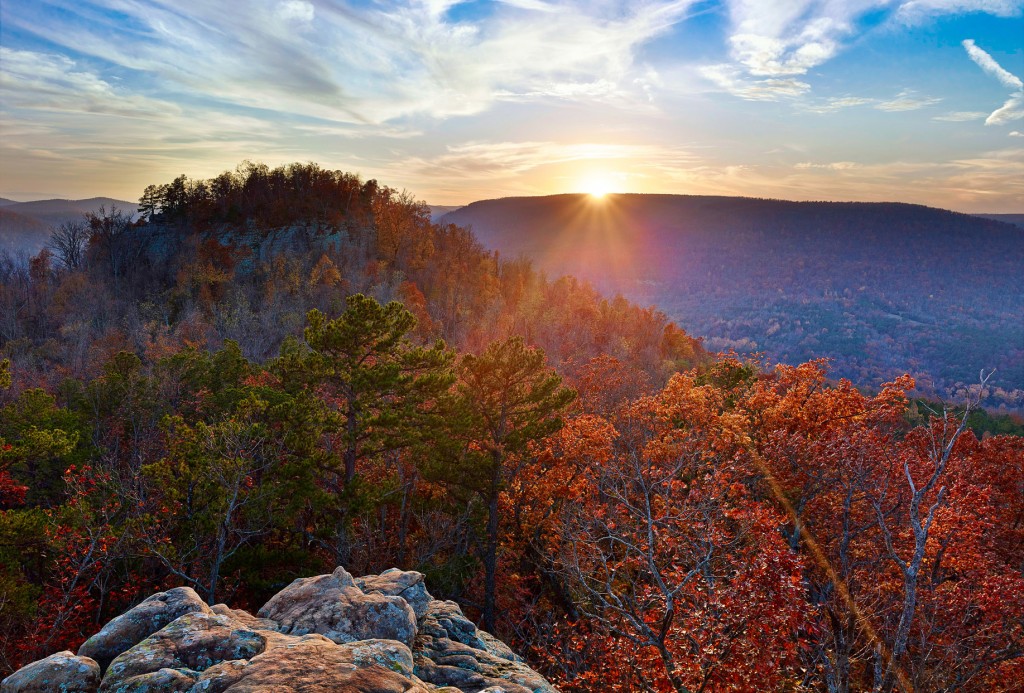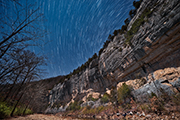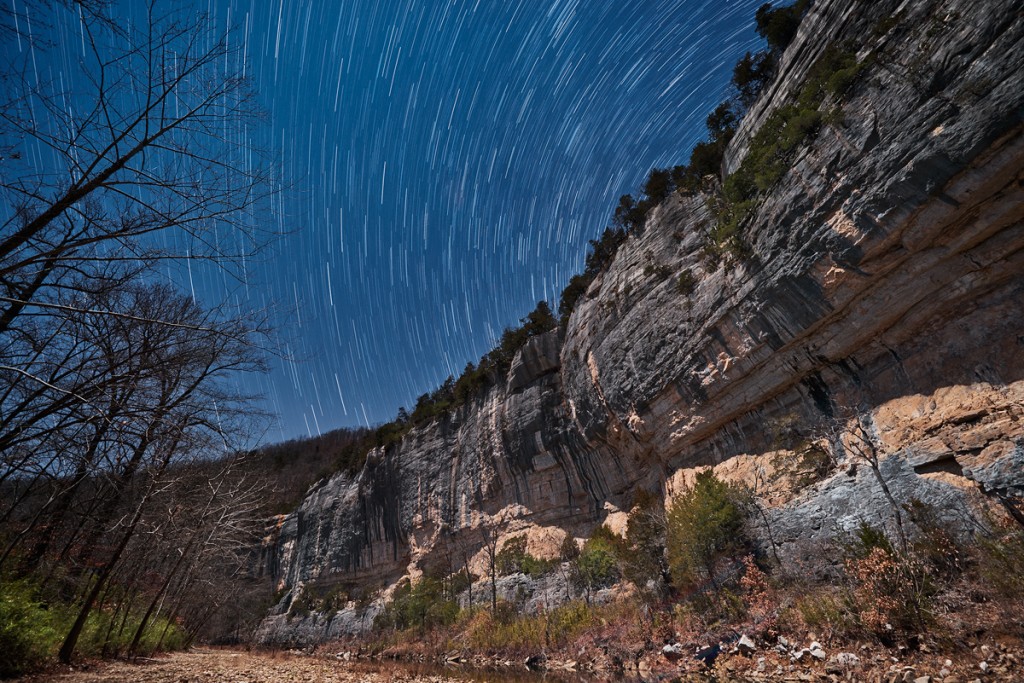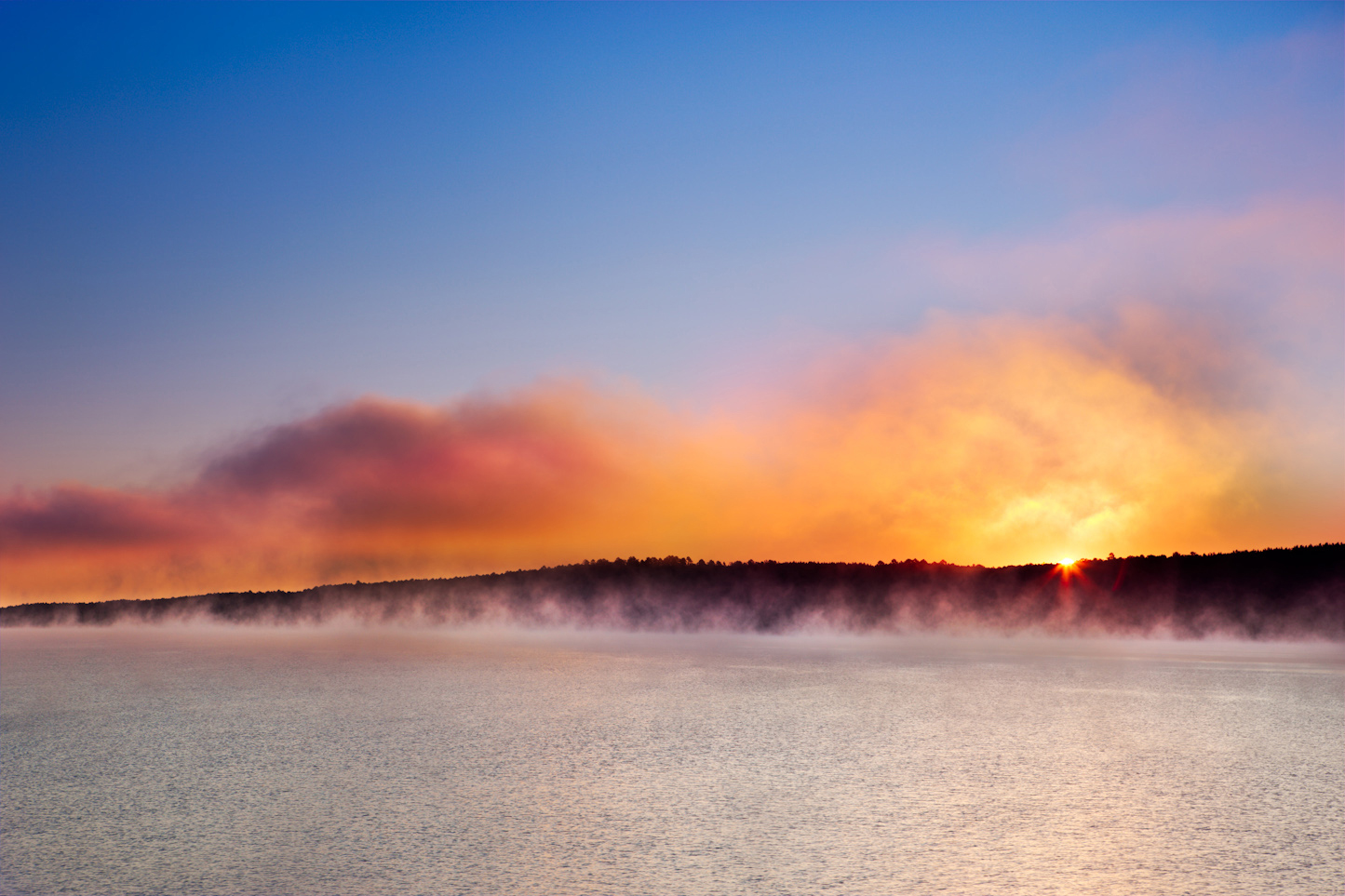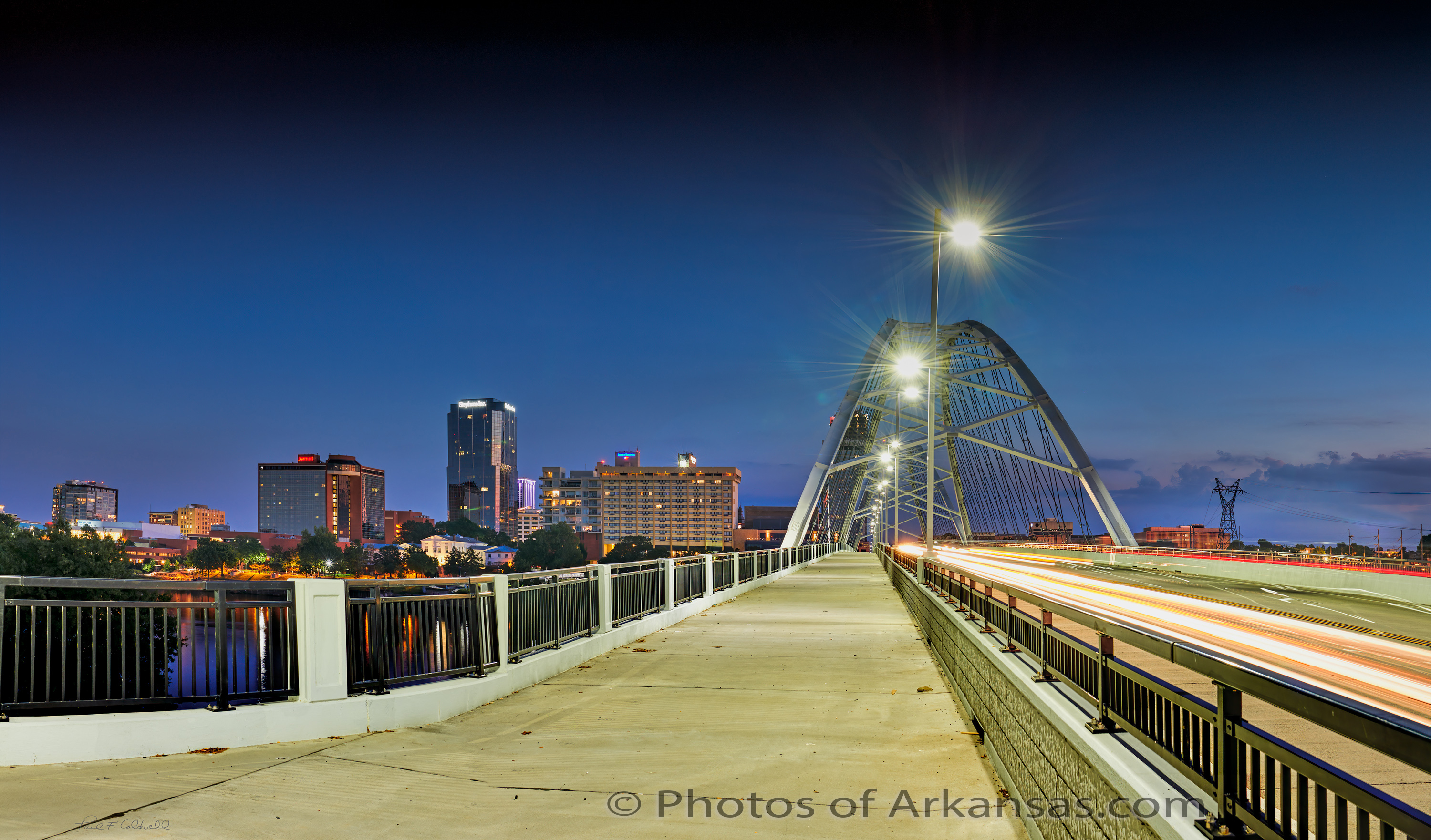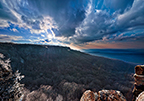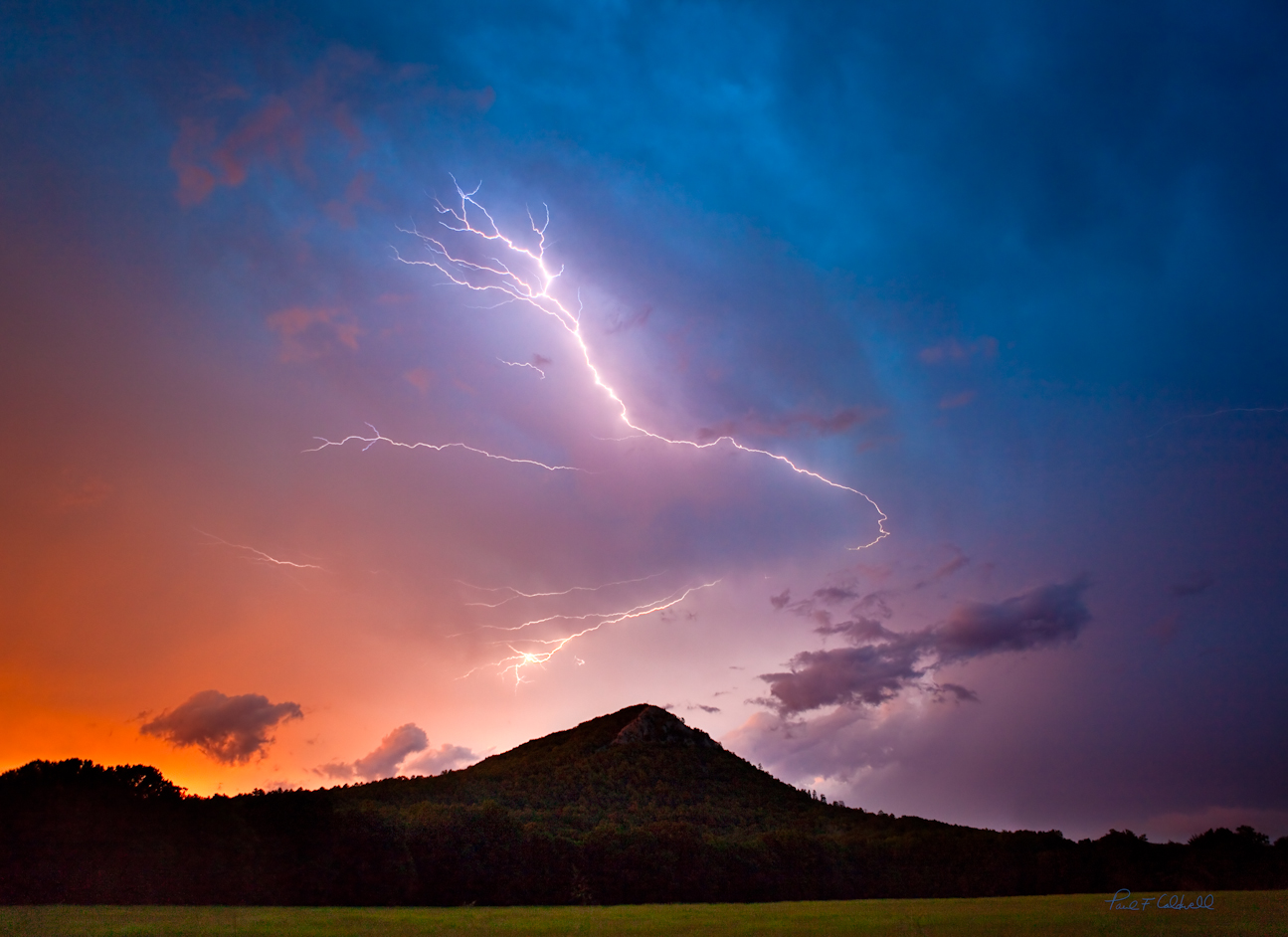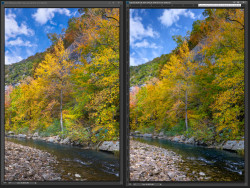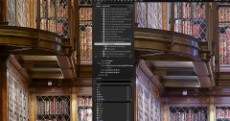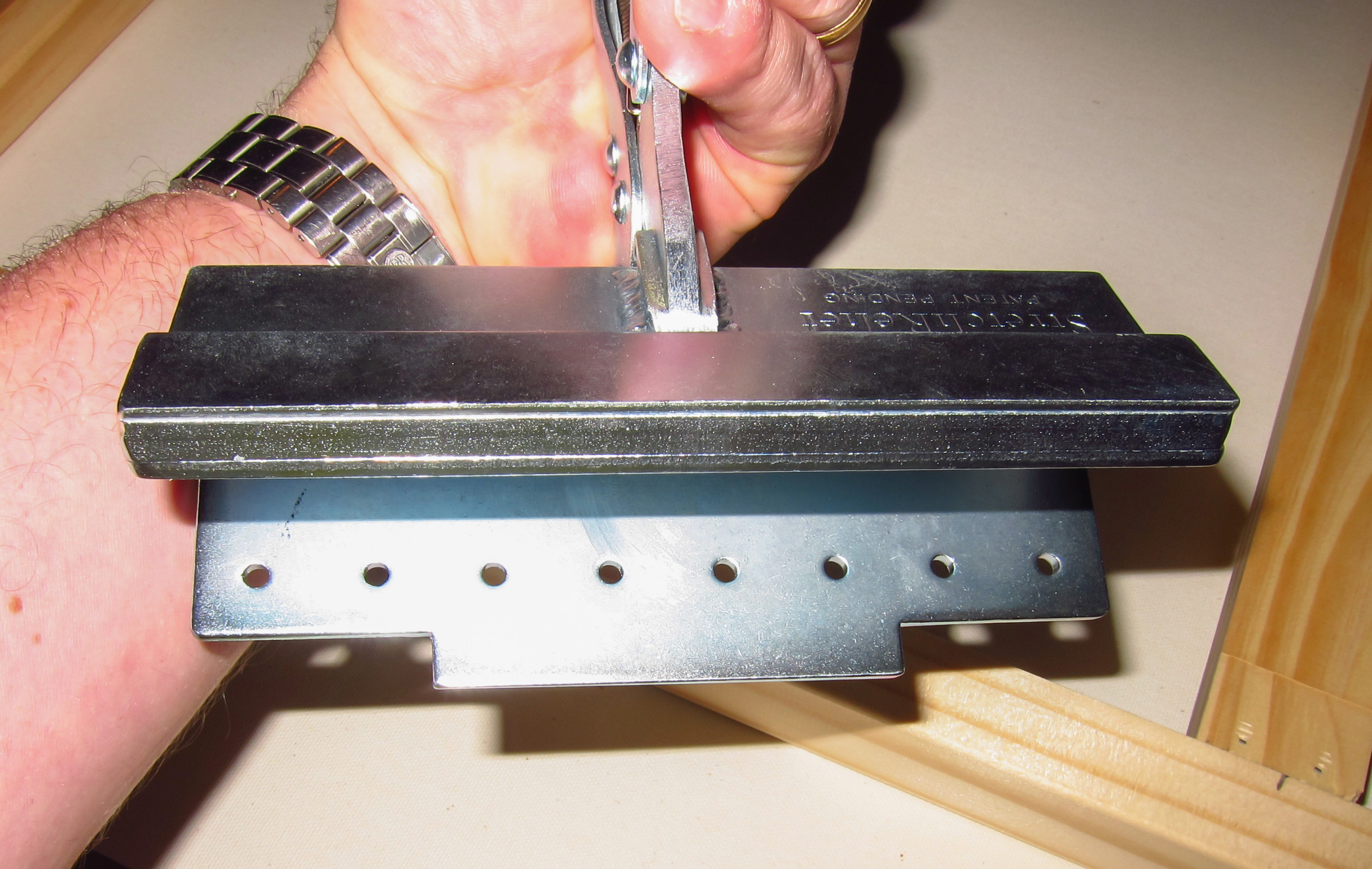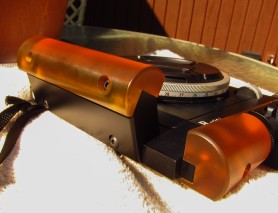06/14/13 Featured Arkansas Photography–Fall scene at Gunner Pool Dam
- At June 14, 2013
- By paul
- In Featured Arkansas Photography
 0
0
Taken with a Canon 1ds MKII, iso 100, Canon 24-70 lens @24mm F8, for approximately 3 seconds. Gunner Pool campground is one of the scenic gems tucked away in the middle of the Arkansas Ozark mountains. This photograph was taken in 2008 in the middle of a wonderfull fall photographic season. The night before it had rained and the small creek that creates gunner pool was starting to run over the top of the dam. Many people feel that gunner pool is in Sylamore Creek, which is right next to this spot, however pool that the campground is named for is the one created by the dam. Sylamore creek is a wonderful spot to camp, and has one of the best campgrounds in Arkansas. It’s always pretty crowded so if you are planning a trip up there in the summer, plan on getting there early and on a weekday if at all possible. The lower 5 campsites at gunner pool are along Sylamore creek and they the best ones. There is also a great swimming spot in Sylamore creek which is bordered by a nice bluff.
06/10/13 Featured Arkansas Photography–Springtime at Cedar Falls on Petit Jean Mountain
- At June 10, 2013
- By paul
- In Featured Arkansas Photography
 0
0
Taken with a Phase One P45+, Mamiya 35mm F3.5 Lens at F14, iso 50, Exposure for approx 1.5 seconds. Here are my print prices if you would like to purchase a print of this photograph My website features many photographs of Cedar Falls on Petit Jean. Petit Jean is about a 40 minute drive from Little Rock and is one of the largest State Parks in Arkansas. It’s not a well known fact that before Hot Springs National Park was created, there was serious consideration to make Petit Jean a National Park instead. Cedar Falls is one of the highest “real” waterfalls in Arkansas. There are many other spots where water will run over a bluff during a heavy rain and create a temporary waterfall, but not many of them flow year round. You can hike down to the base of Cedar Falls from a trail that starts up at the back of Mather Lodge. The trail itself passes many very pretty spots that may warrant a quick stop. This photograph was taken at the peak of spring when the single red bud at the base of the falls is in full bloom. One of the features of Cedar Falls is that there is almost always someone standing around the base of the falls and they tend to be in the way of a good photograph. On this day, I was lucky enough to have the falls to myself for almost 2 hours and that was plenty of time to capture some great images. This photograph was taken with a Phase One P45+ Medium format digital back and a Mamiya 645 camera.
05/08/13 Featured Arkansas Photography–Cossatot Falls State Park near Mena Arkansas
- At May 08, 2013
- By paul
- In Featured Arkansas Photography
 0
0
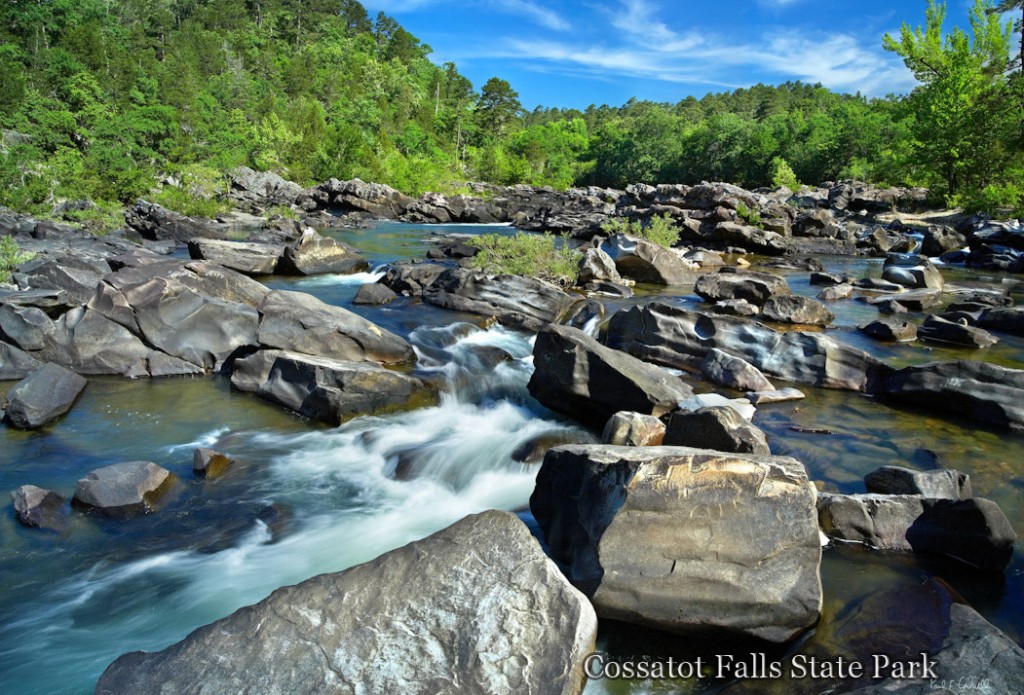
Cossatot Falls viewed from BMF rapid on the Cossatot River in Southwestern Arkansas–click on image for a larger view
Taken with a Canon 1ds-MKII, Zork adapter, 35mm Pentax FA lens, F11, iso 100 for approximately 1 second. The Cossatot River is one of the great scenic spots in the southwestern corner of Arkansas. The Cossatot runs due south and eventually creates Lake Greason. From there is continues to run into Millwood lake, one of the largest impoundments in the southwestern part of the state. This photograph was taken much further upstream in the area known as the six falls. Cossatot Falls is unique to Arkansas rivers as here you will find 6 distinctly different rapids that have cut through the sandstone ridges in different places. Each spot has a unique name, BMF, and the Washing Machine are two of the most famous. This photography is looking back upstream from BMF and features 3 of the falls. I took this shot with a Canon digital camera, with a Zork adapter that allows you to to 3 separate portrait frames as stitches. I then will combine the 3 frames into 1 landscape image. You gain a tremendous amount of resolution by shooting in this format.
04/21/13 Featured Arkansas Photography–Sunrise over Bee Bluff on the Buffalo River
- At April 21, 2013
- By paul
- In Featured Arkansas Photography
 0
0
Taken with a Canon 5D MKII, Canon 24-70 lens @ 24mm, Image is a composite of several different exposures. There are times that I will remember more than others on the Buffalo River. This photograph is one of those days as I had a great landscape opportunity on this morning. While everyone else was out chasing the Elk, (which are a bit on the tame side) I found this scene near Roark and Bee bluffs. The trees around this area vary from Maple, Sweet Gum and various Oaks. Most often in the fall in Arkansas the various trees tend to change colors independently and don’t come together to give a great color display. This spot near Steel Creek landing features two of the most prominent bluffs on the upper river and in the fall you can sometimes catch early sunrise shots like this one. There was no wind and just a bit of light fog was rolling across the tops of the trees below the bluff. I was able to shoot this scene only by using several different exposures to catch the bright sun and deep shadows in the foreground. I am now finding that with a Nikon D800 many times scenes like this can be taken with just one exposure due to the extreme dynamic range of the sensor of the D800.
04/12/13 Featured Arkansas Photography–Midday autumn calm along the Buffalo River
- At April 13, 2013
- By paul
- In Featured Arkansas Photography
 0
0
Taken with a Nikon D800e, Nion 24mm 1.4 lens @ F7.1 1/250 of a sec shutter speed, iso 200. On this day, the conditions were constantly changing. I had been up on top of Roark Bluff most of the morning, but a large mass of clouds rolled in and pretty much shut things down for the morning. I had gone back to my truck and I was figuring out where to head next when the clouds started to part. The blue sky came out and within 20 minutes all of the clouds were gone! I prefer to have some clouds in the sky when working with large masses of blue since the clouds will help break up the sky and allow for the use of a polarizer on a wide angle lens. If I had just been shooting a solid blue sky, even at 24mm, due to the angle of the sun I would of had the classic dark to light polarized effect that wide angle lenses can create. However on a day like this with muted sunlight, you really want to have a polarizer on since it will make the colors in the leaves really stand out. The polarizer also defeated any refection I was going to get on this shot but I felt it was a fair trade off.
03/31/13 Featured Arkansas Photography–Sunrise over Bee Bluff on the Buffalo River in Arkansas
- At March 31, 2013
- By paul
- In Featured Arkansas Photography
 0
0
Taken with a Canon 5D MKII, Canon 16-35mm Lens, 3 exposure raw bracket converted in LR to final image. When you consider the Buffalo River, one the most beautiful times to photograph is fall. The last couple of years, the fall along the Buffalo has been lacking in overall color. There were spots that contained excellent color but for the most part especially along the ridge tops, most of the trees just turned brown. This spot which is featuring two of the most famous river bluffs, Roark and Bee bluffs, has a great line of gum and maple trees at the base of the bluff. On this day, I was there early hoping for a valley full of fog, instead I only found a slight amount in the immediate trees, but with the rising sun and dramatic clouds that were present it still made for a great shot.
03/30/13 Adding a Grip Extension to a Arca Swiss Rm3di–Getting a better handle on things
- At March 31, 2013
- By paul
- In Phase One & Arca Camera
 0
0
- Stock Arca Swiss Grip
- Attempting to grip a Arca Swiss rm3di camera
One of the more unique aspects of the Arca rm3di camera are the orange/yellow horizontal and vertical grips. These grips are made from a smooth plastic material that seems very durable. However the grip for the vertical extension has one rather minor issue, clearance for fingers around the grip. Arca does not allow for any extra height and the stock grip fits flush to the camera body. Also Arca does not allow for a left side grip. This to me is a huge oversight in the design since you can only grip the camera/lens and digital back on the right side. If you are right handed, you have to dedicate your control hand to move the camera around, similar to how a DSLR works. In my workflow, I would like to be able to hold the Arca with my left hand, which would allow me to make easier adjustments, like for tilt, shift, aperture, shutter speed and focus.
The larger issue however is that you don’t have a solid and secure grip when using the stock vertical grip. I have a large hand, but even with a smaller had, there is not enough height to get any purchase on the grip. When you consider the fact that you are holding a camera, lens and a digital back with a value of over 30K, you want to be sure when you grasp the vertical handle that you have a solid purchase. Since the handles designed by Arca don’t have finger indentations, you are looking for the ability to wrap your fingers around the handle and dig into something solid. After I worked with my rm3di for a few months, I realized I needed something more, and I reached out to Rod Klukas, the U.S Arca Rep. Rod informed me that Arca made a “grip extention” and I ordered one immediately.
- Close up of grip extension for Arca rm3di
- Arca rm3di grip extension mounted to camera
The Arca rm3di grip extension made from one piece of material. It is concave on the inside which will allow the user to get a very secure grip on the handle. To install it one simply unscrews the current handle and places the grip extension in the same place. The holes line up perfectly and you use the new screws that are included with the grip extension. Then it’s simple process to screw back on the stock Arca grip. Arca has designed a very secure solution here. The grip is angled outward and presses right up against the back of the camera. The fact that it’s angled outwards gets the grip away from the mounted lens and thus your fingers will not be hitting the lens or shutter.
- View looking directly down on the Arca rm3di showing how secure the grip is
- Arca rm3di with grip installed showing outward angle
- Arca rm3di with grip extension mounted view from back of camera
Once it’s mounted, make sure to place the included allen wrench somewhere secure. I just keep mine with the camera body in the case I use. I have had my grip installed now for over a year and I have never had anything come lose. When I installed it I put just a bit of blue thread locker on my threads. The grip extension gives me total confidence when I pick up the rm3di with a Phase One digital back installed. I have carried this camera/digital back combination over pretty rough terrain and in streams with no concerns at all. My only issue is that Arca just don’t include the grip extension with the base price of the camera. The additional cost of the grip extension is approximately $385.00 and you may have to wait a while to get one. I ordered mine from Rod Klukas directly.
Here is a link to Rod’s website: www.Rodklukas.com
03/26/13 Featured Arkansas Photography–Sunset over Sam’s Throne in the Arkansas Ozarks
- At March 26, 2013
- By paul
- In Featured Arkansas Photography
 0
0
Taken with a Phase One IQ-180, Schneider 43 Super Digitar lens, F11, iso 100, exposure time 1/30 sec. This was a strange day, as the wind was blowing about 20 to 30 mph and just standing around trying to take the picture was a bit dangerous. Sam’s Throne is a great place to spend a day and or night as there is now a informal maintained campground. Sam’s Throne is the single large hill out in the distance but the entire valley has some wonderful views. I like to try and catch a sunset there working to catch the sun illuminating the throne in the background. This area is frequented by climbers so be prepared to watch some interesting activity on the rocks. The rocks are mainly sandstone and will take on a deep orange yellow color with the sun shining on them. The valley is surrounded by oaks and hickory trees which tend to have great display of fall color.
03/15/13 Featured Arkansas Photography–Night skies over Roark Bluff on the Buffalo River
- At March 15, 2013
- By paul
- In Featured Arkansas Photography
 0
0
Taken with a Nikon D800e, Nikon 14-24 Lens @ 14mm, F4.5, iso 400, total exposure time approximately 40 minutes. This shot was taken back in January, but it was a great night to be out shooting the stars. The temperature was around 29 degrees and there was virtually no wind. We started shooting at dark and by about 1 hour into the night we were getting excellent runs. This shot is a composite of 40 minutes taken in 2 1/2 minute exposures at iso 400. I will then stack the exposures to catch the motion and create the trails. The blue sky is due to the moon. If you work with the moon at night you will be pleasantly surprised by the results. It will give a nice blue hue to the sky and also provide all the illumination to the bluff that you see in this photograph. This is not a daylight/nighttime exposure as many people think. This is all done at night with the aid of the moon. As was looking up, it makes the perspective of the trees a bit more interesting, as if they are looking into the photo. I am going to start working at night with a Canon 24mm TS-E for perspective control where it will give me a good enough FOV, which on this shot I needed all of the 14mm I could get. You are looking to feature the sky, but you still want to get as much of the foreground as possible.

